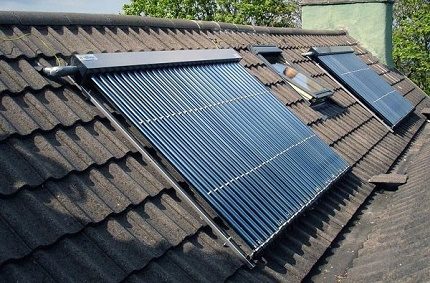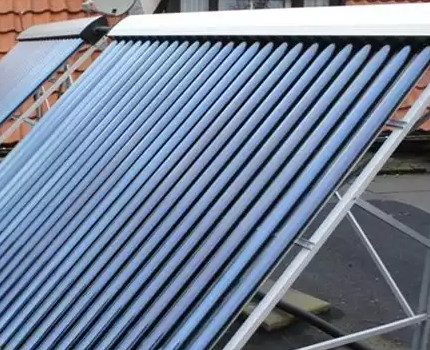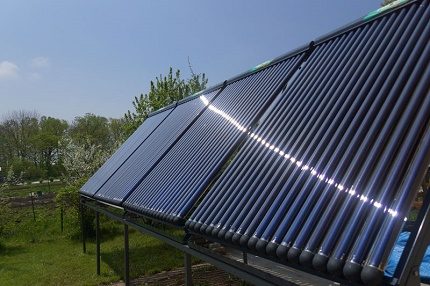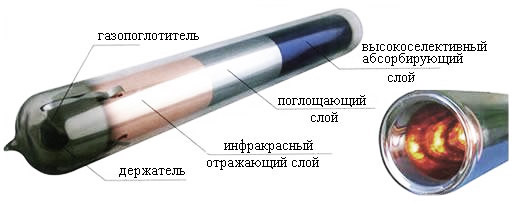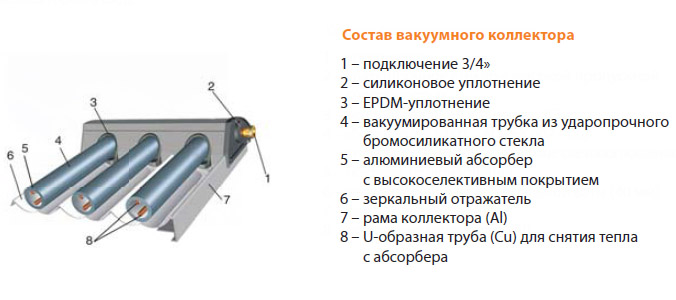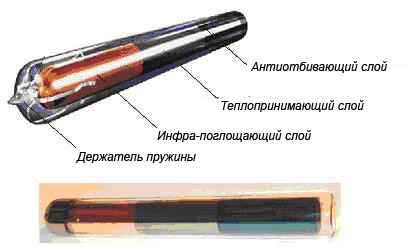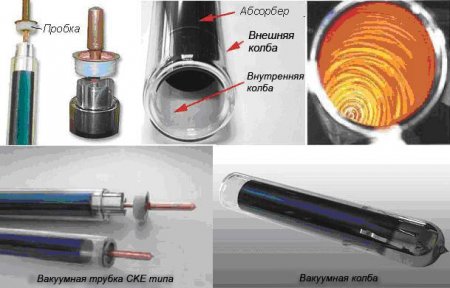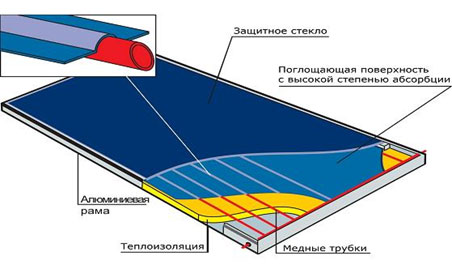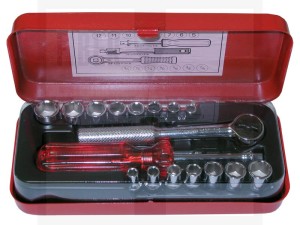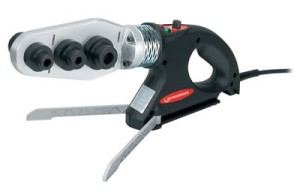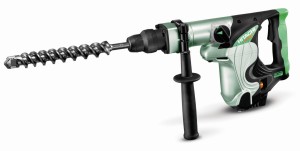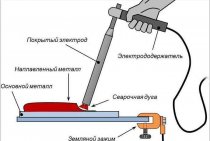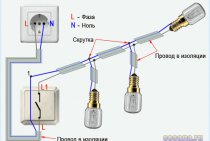Types of vacuum tubes
There are five types of vacuum tubes for solar collectors. They differ in internal structure and design. In addition, each of them can be supplemented with a metal (usually aluminum) absorber, which is placed inside a glass flask in the form of a tube.
Important!
Most manufacturers fill the lower gap between the glass walls with barium - it absorbs gas impurities and improves thermal insulation properties. Its absence can reduce the efficiency of the collector up to 15%.
Thermosiphon (open) vacuum tubes
This type of solar collector tubes is used in collectors with an external storage tank. they are filled with water and form one volume with the tank. The heated water from the flask rises into the tank, and the cooled water falls down.
Thermosiphon vacuum manifolds are used in the following applications:
- For connection to the hot water supply system;
- In regions with a high level of insolation during the cold season;
- For seasonal use (spring, summer, autumn).
Coaxial tube (Heat Pipe)
This is the most common type of vacuum tube. In it, inside a glass flask, there is a copper tube filled with a liquid with a low boiling point or water under low pressure.
When heated, the liquid or water begins to boil, the steam rises, simultaneously heating up from the copper walls. In the upper part, it enters the heat exchanger - an extension at the end, in which it gives off heat through the walls to the water that circulates around it.
After cooling, the steam condenses on the walls of the heat exchanger and flows down. The cycle is repeated anew.
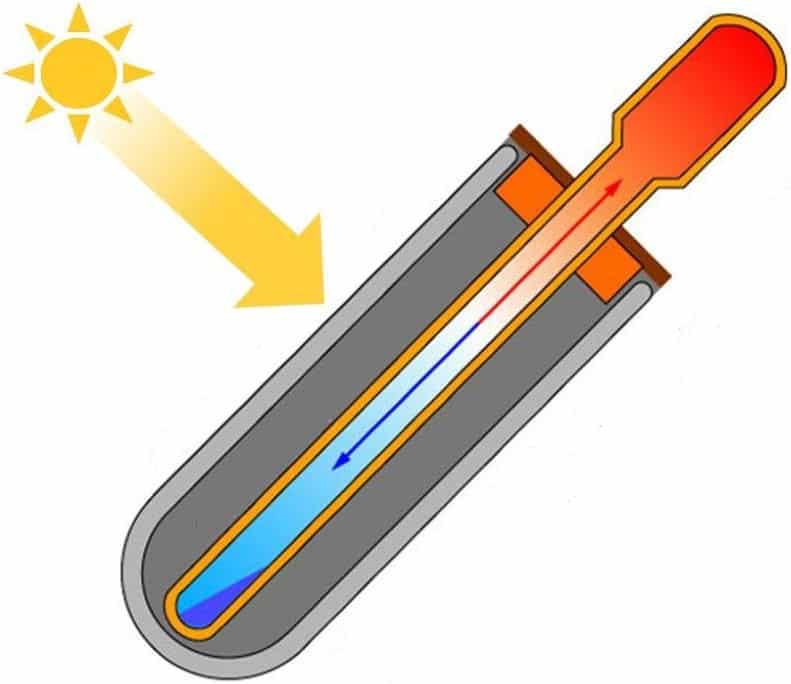
Twin coaxial tubes
The principle of operation of such a heat receiver is the same as that of the previous one, with one exception - two copper tubes with liquid are connected to one heat exchanger. The twin system allows for more efficient heat removal, and the large capacity and area of the heat exchanger walls quickly heat the water.
Vacuum manifolds with a twin coaxial system are installed where necessary:
- Provide a small heating of large volumes of water;
- There is a need for thermal energy during a sunny day;
- High average level of insolation;
- There is a rapid pumping of water through the system.
Feather vacuum tubes
Their design has an additional heat exchanger, which allows more efficient removal of heat from the inside of the glass bulb. Usually it is made in the form of two longitudinal plates located on the sides of a copper heat sink.
Otherwise, the principle of operation is exactly the same as that of a coaxial tube.
U-shaped vacuum tubes (U-type)
This system is fundamentally different from the previous ones. It uses two lines - for cold and heated water.
A heat exchanger in the form of an English letter U is installed in a glass flask, through which water flows. From the line with cold water, it enters it, heats up and returns to the pipe with heated water.
The U-tube manifold is the most efficient, but installation is more difficult. The flow lines during assembly are fastened by welding with copper tubes inside the glass bulb. It turns out a single integral system with great energy efficiency, but low maintainability.
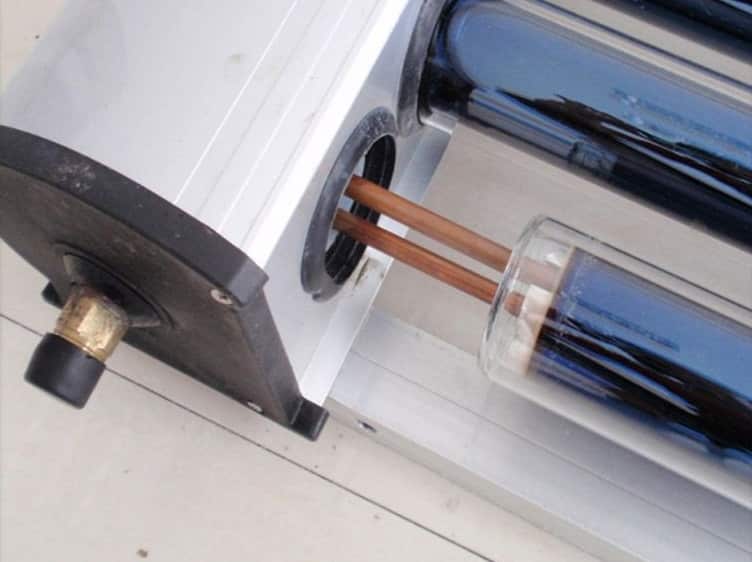
Pros and cons of vacuum type collectors
The main advantage of the units is the almost complete absence of heat loss during operation. This is provided by a vacuum environment, which is one of the highest quality natural insulators. But the list of benefits does not end there.Devices have other pronounced advantages, for example:
- work efficiency at low temperatures (up to -30 °С);
- ability to accumulate temperatures up to 300°C;
- maximum possible absorption of thermal energy, including the invisible spectrum;
- operational stability;
- low susceptibility to aggressive atmospheric manifestations;
- low windage due to the design features of tubular systems capable of passing through them air masses of different densities;
- high level of efficiency in regions with a temperate and cool climate with a small number of clear and sunny days;
- durability subject to the basic rules of operation;
- availability for repair and the ability to change not the entire system, but only one failed fragment.
The disadvantages include the inability of the collectors to self-clean from frost, ice, snow and the high price of the components needed to assemble the unit at home.
How to place the device correctly
In order for the vacuum collector to work fully and effectively provide the living space with the necessary energy, it is necessary to find the most suitable place for it and correctly orient the device relative to parts of the world.
For settlements of the northern hemisphere, it is important to place the collector in the southern part of the roof of the house or on the sunny side of the site. It is desirable to ensure a minimum deviation for the instrument plane.
If it is not possible to direct the surface to the south, it is worth choosing among the west and east the most light angle in the open space.
The energy solar complex should not be covered by chimneys, decorative fragments of roofing, sprawling tree branches and tall residential or technical buildings. This will reduce the efficiency of work and reduce the level of heating of the active elements.
If the unit is located correctly, it will provide almost the same heat output throughout the year, regardless of the season.
If there is no great experience in carrying out complex repair, installation and plumbing work, it is irrational to do evacuation of tubes at home. This process is very time-consuming and requires special knowledge and specialized equipment.
In addition, self-made vacuum-type elements have a much lower level of efficiency than factory parts. Therefore, it is most reasonable to purchase products from a specialized manufacturer, and then try to assemble several sections at home.
Varieties of solar panels
Classification of solar systems occurs according to the design features of the tubes and the type of thermal channel used as a receiver:
1. The coaxial model of a vacuum solar collector for home heating is a double glass bulb, in the cavity of which air is pumped out. An absorbent coating is applied to the surface, so the energy transfer occurs from the tube itself.
2. The feather structure is single-walled, the void here is located in the space of the thermal channel, part of which, together with the accumulator, is integrated into the flask.
4. In forced circulation systems, a low-power pump is installed to help move the media. At the same time, the power consumption is much less than the energy received for heating a private house.
5. There is also a difference in the number of circuits. In the simplest collectors, heating water is heated and consumed from a storage tank.
6. More complex ones consist of a vacuum tube and liquid sampling elements. The device contains a non-freezing and non-toxic carrier with anti-corrosion and anti-foam additives. This method reliably protects the equipment from salts and scale and contributes to a longer operation during heating.
Overview of models and their characteristics
At the moment, China holds the lead in the production of collectors powered by solar energy.According to the reviews of the owners of private houses, domestic manufacturers also supply equipment with good characteristics for sale. European devices are quite expensive, but over time, the cost of buying and installing devices is fully justified. The most famous companies produce the following collectors:
Plumbers: You'll pay up to 50% LESS for water with this faucet attachment
Collectors Dacha and Universal are the most famous devices of a domestic manufacturer. The SCH-18 is highly efficient with condensate temperatures up to 250°C. The flasks are made of red copper, the coolant is liquid. The absence of water in the vacuum ensures frost resistance. The strong case well resists to wind. The pipeline is protected by a polyurethane manifold. Rubber anti-dust seals prevent dust and precipitation from entering.
They work effectively at temperatures up to -35°C, the type of functionality is a pressurized system for heating. There is a controller for controlling the heater, the size of the tubes is 1800 mm, the volume of the tank is 135-300l, the power of the heating element is 1.5-2 kW. Collectors are manufactured in accordance with international certifications, which ensures their safety and reliability.
Collector selection criteria
If the plans include buying a vacuum manifold for heating, you should pay attention to a number of nuances that will help you decide on the model:
1. A tubular solar system is suitable for a flat roof. With a large windage, it will hold firmly and stably.
2. Studying the technical characteristics, you need to take into account the number of tubes, their type, dimensions, equipment area.
3
It is also important to know the volume of liquid, the dimensions of the device, the surface of the absorber, the quality of the glass of the flasks and the thickness of the insulator.
4. To calculate the real performance, it is necessary to find out the heating area, the amount of heat loss, climate features, hot water consumption per day.
5. When purchasing a collector, you also need to take into account the additional costs for installing components: tank, battery and exchanger.
User opinions
Despite the rather high cost, solar installations have received great interest, as evidenced by the feedback from the owners who used such heating systems:
“In order to save money, I had to pay attention to solar collectors for use in a private boarding house. During the season, the consumption of hot water is quite large, it was necessary to choose an alternative method of supplying hot water and heating
The Chinese manufacturer Shentai offers to buy equipment at an affordable price, so I settled on their products, especially since the reviews are mostly positive. According to the calculations, I was recommended the necessary power, they delivered and installed all the equipment quickly. Compared to the cost of a boiler in each room, the savings were enormous. There were no shortcomings or problems in the work.
Evgeny Gonchar, Krasnodar.
“Now all people are trying to switch to a more profitable source of heating. Trusting the reviews, we also ordered a Paradigma collector for our cottage. At first they used it as a backup option, a year later they were convinced of the effectiveness and completely switched to providing the house with a solar system. We were worried that the tubes could be damaged by bad weather or wind, but they are durable, not even afraid of a hurricane. Thanks to the accumulation system, you do not have to worry about the termination of work. We did not find any shortcomings, we are satisfied with our choice, although the price is rather high.”
Angelina, Moscow.
“We installed a collector from Andi Group brand SCH-18, as the reviews about the company are good. I am not very versed in technical features, my husband chose the device. But I like that it worked only a season, and the savings are already being felt. True, this year there was a lot of sun, so the accumulation of energy was practically not interrupted.The only drawback is that there is not always enough power, the heating works well, and you have to be more restrained with hot water consumption, since the family is large. Let's see how the collector will show itself in the future."
Marina, Rostov-on-Don.
“I work in a private kindergarten. The owner installed a Micoe solar system on the roof two years ago. The consumption of hot water is constantly required and the rooms must have the optimum temperature, and these are decent costs. With the new equipment, it turns out to fully service the heating, supply hot water without interruption, and also heat the pool. Even at night, all systems function perfectly. Since I didn’t see any shortcomings, I’m thinking of buying the same device for my home, especially since the price is reasonable. You just need to read the reviews to choose the right model.
Daria, Yekaterinburg.
Price
All companies have their own price range for vacuum-type solar collectors.
When laying the budget for a solar heating system, it is important to make preliminary calculations and decide on the appropriate option. The approximate cost is shown in the table:
| Company, manufacturer, model | Absorption area, m2 | Number of tubes | Dimensions, mm | Weight, kg | Price, rubles |
| China
SZ47 MZ58 |
1-3 1,5-4 |
10-30 10-30 |
1700×1000/2300×150 2200×1000/2700×155 |
30-75 40-115 |
20 000-40 000 25 000-50 000 |
| Andi Group, Russia
Cottage XF-II Wagon CP-II SCH-18 |
0,55-0,8 2-5 2,3 |
10-200 15-35 18 |
2350x1000/2050/160 2350x1300/3200/160 2020x1640x155 |
50-100 65-170 55 |
20 000-50 000 60 000-120 000 30 000-35 000 |
| Germany
CPC Star Azzuro Titan Plus |
2,9-5 3-6 |
14-45 20-50 |
1060x1060/2050x120 1100x1200/2200x140 |
39-72 50-120 |
120 000-150 000 140 000 -170 000 |
| Shentai, China, Netherlands
SCM 58 STH 200 |
1,5-2 2-4 |
10-40 15-45 |
2300x1000/2200x150 2300x2000/2200x120 |
40-80 50-120 |
30 000-50 000 60 000- 80 000 |
| Viessmann, Germany
Vitosol 200-T Vitosol 300-T |
2,7-3 3-3,7 |
20-40 20-40 |
1500x2050/3000x150 1500x2050/3000x150 |
60-70 60-80 |
225 000- 300 000 350 000 -420 000 |
How does a vacuum type collector work?
Modern vacuum devices that provide rooms with heat and hot water due to solar energy differ somewhat technologically and are divided into such types as:
- tubular without glass protective coating;
- module with reduced conversion;
- standard flat version;
- device with transparent thermal insulation;
- air unit;
- flat vacuum manifold.
All of them have a common structural similarity, so they consist of:
- external transparent pipe, from which air is completely pumped out;
- a heated pipe located in a large pipe where a liquid or gaseous coolant moves;
- one or two prefabricated distributors, to which pipes of a larger caliber are attached and a circulation circuit of thin tubes placed inside is included.
The whole design is somewhat reminiscent of a thermos with transparent walls, in which an unprecedentedly high level of thermal insulation is maintained. Thanks to this feature, the body of the inner tube acquires the ability to warm up qualitatively and fully give the energy resource to the coolant circulating inside.
Varieties of vacuum collectors
Varieties of vacuum collectors
Two types of glass tubes are used in the design of the collectors:
- coaxial;
- feather.
Let's take a closer look at each of them.
Tube coaxial
This is a kind of thermos, which consists of a double flask. The outer flask is covered with a special substance that absorbs heat. A vacuum is created between the two tubes. This made it possible to ensure that the heat during operation is transferred directly from the glass flasks.
Inside each tube there is another one - copper (it is filled with ethereal liquid). When the temperature rises, this liquid evaporates, transfers the accumulated heat and flows back in the form of condensate. The cycle then repeats over and over again.
Feather tube
Such tubes consist of a single-walled flask. By the way, in terms of wall thickness, they significantly exceed coaxial counterparts. The copper tube is reinforced with a special corrugated plate treated with a moisture absorbent. It turns out that the air in this case is pumped out of the entire thermal channel.
Such channels, by the way, are also different:
- direct-flow;
- "Hitpipe".
Channels like "Hitpipe"
Heat transfer in a vacuum solar collector type “Heat Pipe”
Their other name is heat pipes. They work as follows: the ethereal liquid in closed pipes rises up the channel when the temperature rises, after which it condenses there in a specially equipped heat collector.In the latter, the liquid transfers thermal energy and descends down the tube. From the heat collector, heat is transferred further into the system by means of a circulating coolant.

Coaxial vacuum heat-pipe with 2-pipe manifold
It is characteristic that metal tubes here can be not only copper, but also aluminum.
Straight channels
In each of these channels in a glass tube there are two metal pipes at once. According to one of them, the liquid enters the flask, heats up there and exits through the second.
Advantages and disadvantages
Solar vacuum collectors have lower heat losses compared to flat ones. The use of vacuum nanotechnologies in the production of collectors has made it possible to achieve high efficiency and reliability of solar systems.
Consider the main advantages of using vacuum collectors:
- Performance. There is a vacuum in the collector tubes - an ideal heat insulator, which allows you to maintain an optimal level of heat even in the autumn-winter period. By keeping the efficiency at a high level, the performance of the vacuum collector is 40% higher than that of the flat collector.
- Reliability. The service life of vacuum collectors is about 30 years. Their durability and uninterrupted operation are due to modern durable materials. Vacuum tubes are made of high quality copper. The outer body of the tubes is molded from borosilicate glass, which is able to withstand high loads. The use of vacuum collectors is especially important for climatic zones, where squalls, hurricanes, hail are not uncommon.
- Efficiency of using solar energy. The cylindrical shape of the absorber of the vacuum collector captures and retains even scattered solar energy, which is not able to convert a flat corrector. From one square meter of the absorber of a vacuum solar system, it is possible to retain solar energy by 40% more than from a similar area of a flat-type solar installation. The roundness of the tubes allows you to receive up to 97% of solar energy from early morning until late evening.
- Ease of use. In case of damage to the vacuum tube, it can be replaced without stopping the operation of the system (draining of the circulating liquid is not required). With a lack of heat, you can add several tubes, and with an excess of it, temporarily remove it. After cleaning the vacuum manifold from snow or icing, it quickly comes into working condition. The surface of the collector has low thermal inertia due to the thin glass coating.
- Water disinfection. The temperature of water heating during the operation of the solar system reaches high levels, which ensures its disinfection and prevents the reproduction of pathogenic organisms.
- Ease of installation. When installing vacuum collectors, there are no particular difficulties, the main thing to adhere to is to place the collector at an angle to allow the liquid inside the tubes to flow down.
The disadvantages of solar heating come down to extremely low efficiency at low temperatures and at night, thus raising the question that this heating system cannot be the only one in the house. Also, vacuum solar collectors are more expensive than flat ones.
Vacuum-type solar installations are becoming increasingly popular among the population and large companies. If earlier many were frightened off by the price of the issue, today the cost of equipment has decreased somewhat, and the functionality has improved and been modified.
The principle of operation of the vacuum tube type SKE.
The key to the operation of the solar system is the glass vacuum tube. Each vacuum tube consists of two glass flasks.
The outer flask is made of extremely strong borosilicate glass which withstands hail which falls at a speed of 18 m/s and has a diameter of up to 35 mm.
The inner flask is also made of borosilicate glass and coated with a special three-level coating with a gradual change in absorbing layers ALN/AIN-SS/CU. Through the use of new technologies, a high absorption coefficient and low repulsion ability are achieved, which makes it possible to reach +380 ° C in the middle of the tube in direct sun, without harming the product itself.
Air is pumped out between the two glass bulbs to create a vacuum that prevents reverse heat conduction and convection heat loss. In the middle of the glass bulb there is a hermetic heat pipe (HEAT PIPE), made of pure red copper, in the middle of which there is a light-boiling and evaporating liquid, which performs the function of transferring heat to the coolant. The figure below shows the working principle of a vacuum tube.
The main intensity of solar radiation under terrestrial conditions is in the spectral range 0.28 µm – 3 µm. Borosilicate glass transmits solar radiation waves in the range of 0.4 microns - 2.7 microns. Penetrating through the outer transparent flask, the energy is retained on the second flask, which is coated with a highly selective opaque absorber layer.
As a result of the absorption of light by the absorber and its subsequent emission, the wavelength increases to 11 microns. Glass is an impenetrable barrier to an electromagnetic wave of this length. Solar energy, falling on the absorber, is trapped. Absorbing solar radiation, the absorber, even without an external flask, can heat up to a temperature of + 80 ° C. The absorber heated to such a temperature emits thermal energy, which, penetrating through the body of the second flask, is transferred to the HEAT PIPE. Due to the occurrence of the greenhouse effect, which is based on the accumulated energy under the glass, in the middle of the second flask the temperature rises to +180°C. This heat heats a low-boiling and evaporating liquid, which at +25°С - +30°С, turning into steam, rising, transfers heat to the working part of the HEAT PIPE, where heat exchange with the coolant takes place. The release of heat causes the steam to condense and flow into the bottom of the HEAT PIPE, and the cycle repeats again.
The high coefficient of heat transfer by easily boiling and evaporating liquid, its small amount and the relatively small size of HEAT PIPE provide effective thermal conductivity. HEAT PIPE works like a thermal diode. Thermal conductivity is very high in one direction (up) and low in the opposite direction (down).
In order to maintain a vacuum between two glass flasks, a layer of barium is applied to the lower interior of the flask. It actively absorbs CO, CO, N, O, HO and H during tube storage and operation. The barium layer also provides a clear visual indication of vacuum status. White color means that the vacuum conditions are violated.
The ideal combination of vacuum and thermal copper tubes gives us the following advantages over flat-plate collectors:
High thermal efficiency. thanks to modern methods of heat transfer, high-quality absorbent coating.
Wide range of work: due to the low thermal capacity, it is able to work in high clouds (in the infrared range of rays that pass through the clouds).
Each tube works independently from one another. Since the antifreeze does not flow into the middle of the tube, and its access is limited by the heat exchanger, in the event of physical damage, the collector continues to work.
Less weight of the collector with better efficiency of the collector itself.
Better working efficiency in winter thanks to vacuum. The tube can withstand temperatures down to -50°C.
Working principle of vacuum tubes
The function of the evacuated tubes of the solar collector is to absorb solar radiation and prevent it from escaping into the environment.Thermal energy can leave the working part of the vacuum solar collector in two ways - due to direct heat transfer and in the form of infrared radiation.
The cavity between the glass walls almost completely eliminates the possibility of direct heat transfer in vacuum, there are no molecules of substances that could carry out its transfer.
The selective covering (absorbent) provides absorption of solar energy and does not allow it to go outside. There are different types of such coatings, differing in absorption and emissivity.
Glass reflects some of the solar radiation, but it is insignificant - visible light makes up only part of the absorbed spectrum. Quality collectors are made of high-strength borosilicate glass, which is resistant to mechanical damage.
Borosilicate glass is difficult to scratch or matte, and lasts for decades without changing throughput.
Flat collectors
A flat solar collector heats the coolant using a plate absorber. It is arranged quite simply. In fact, this is a plate of heat-intensive metal, painted black on top with special paint. A serpentine tube is tightly attached (welded) to the lower surface of the plate, through which the liquid circulates.
Black selective paint provides maximum absorption of sunlight, and their reflection is almost zero. The absorbed rays heat the coolant under the absorber, which, in turn, is fed further into the system. To minimize heat loss, the absorber is insulated from the collector body and tempered glass, which contains almost no iron oxides. It is installed above the absorber and acts as the top cover of the housing. In addition, the use of such glass allows you to create a kind of "greenhouse effect", which further increases the heating of the absorber, and hence the temperature of the coolant.
How to assemble an air manifold
If you decide to assemble the solar system with your own hands, first take care of all the necessary tools.
What will be required in the work
1. Screwdriver.
2. Adjustable, pipe and socket wrenches.
Socket wrench set
3. Welding for plastic pipes.
Welding for plastic pipes
4. Perforator.
Perforator
Assembly technology
For assembly, it is desirable to acquire at least one assistant. The process itself can be divided into several stages.
First stage. First, assemble the frame, preferably immediately in the place where it will be installed. The best option is the roof, where you can separately transfer all the details of the structure. The very procedure for mounting the frame depends on the specific model and is prescribed in the instructions.
Second phase. Fasten the frame firmly to the roof. If the roof is slate, then use a sheathing beam and thick screws; if it is concrete, then use ordinary anchors.
Typically, frames are designed to mount on flat surfaces (maximum 20-degree slope). Seal the frame attachment points to the roof surface, otherwise they will leak.
Third stage. Perhaps the most difficult, because you have to lift a heavy and dimensional storage tank onto the roof. If it is not possible to use special equipment, wrap the tank in a thick cloth (to avoid possible damage) and lift it on a cable. Then attach the tank to the frame with screws.
Fourth stage. Next, you have to mount the auxiliary nodes. This may include:
- heating element;
- temperature sensor;
- automated air duct.
Install each of the parts on a special softening gasket (these are also included).
Fifth stage. Bring on the plumbing. To do this, you can use pipes made of any material, as long as it can withstand a temperature of 95 ° C heat. In addition, the pipes must be resistant to low temperatures. From this point of view, polypropylene is most suitable.
Sixth stage. After connecting the water supply, fill the storage tank with water and check for leaks. See if the pipeline is leaking - leave the filled tank for several hours, then carefully inspect everything and, if necessary, fix the problem.
Seventh stage. After making sure that the tightness of all connections is normal, proceed with the installation of the heating elements. To do this, wrap a copper tube with an aluminum sheet and place it in a glass vacuum tube. Place a retaining cup and a rubber boot on the bottom of the glass flask. Insert the copper tip at the other end of the tube all the way into the brass condenser.
It remains only to snap the cup-lock onto the bracket. Install the rest of the tubes in the same way.
Eighth stage. Install a mounting block on the structure and supply 220 volt power to it. Then connect three auxiliary nodes to this block (you installed them in the fourth stage of work). Despite the fact that the mounting block is waterproof, try to cover it with a visor or some other protection from atmospheric precipitation. Then connect the controller to the unit - it will allow you to monitor and regulate the operation of the system. Install the controller in any convenient place.
This completes the installation of the vacuum manifold. Enter all the necessary parameters in the controller and start the system.
